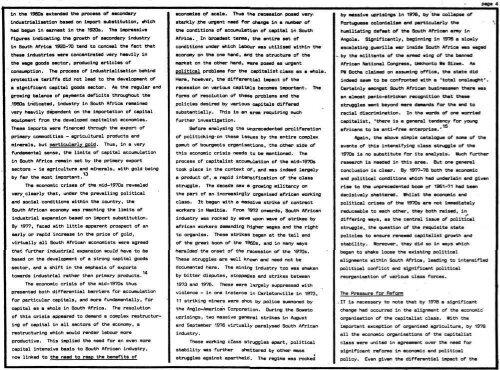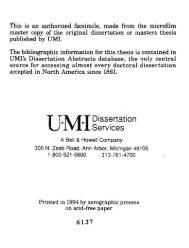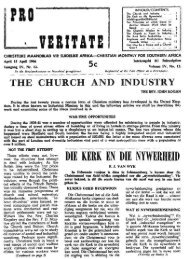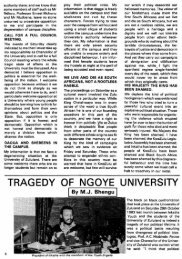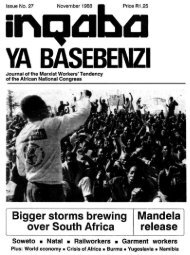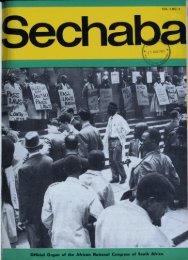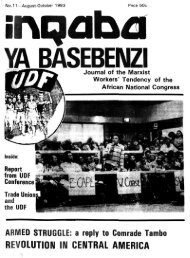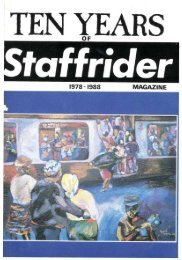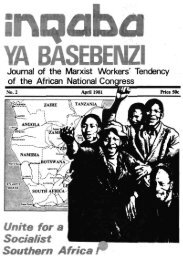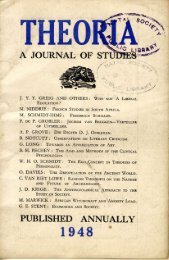You also want an ePaper? Increase the reach of your titles
YUMPU automatically turns print PDFs into web optimized ePapers that Google loves.
in the 1960s extended the process of eecondary<br />
industrialisation baaad on import substitution, which<br />
had begun in earnest in tha 1920s. Tha impressive<br />
flQuras indicating, tha growth of sacondary industry<br />
in South Africa 1920-90 tand to concaal tha fact that<br />
thass industriaa were concentrated vary heevily in<br />
tha wage goods sector, producing artlclat of<br />
consumption. Tha procass of Industrialisation behind<br />
protactlva tariffs did not laad to tha davalopaant of<br />
a significant capital goods ssctor. As tha ragular and<br />
growing balancs of payments daflclts throughout tba<br />
1960s lndloatadt Industry in South Africa raaainad<br />
vary haavily dependent on tha importetion of capital<br />
equipment froa tha developed capitalist economies.<br />
Thasa imparts were financad through tha axport of<br />
primary commodities - agricultural products and<br />
minerals, but particularly gold. Thus, in a wary<br />
fundaaantal sense, tha limits of capital accumulation<br />
in South Africa remain sat by tha primary axport<br />
sactors - la agriculture and minerals t aith gold baing<br />
by far tha aost important.<br />
Tha economic crises of tha mid-1970s revealed<br />
vary claarly that, undvr tha prevailing political<br />
and social conditions within tha country, tha<br />
South African aconomy mas raachlng tha limits of<br />
industrial expansion based on Import substitution.<br />
By 1977, facad mith little apparent prospect of an<br />
early or rapid lncraasa in tha price of goldt<br />
virtually all South African aconomlsts mere agreed<br />
that furthar industrial axpanslon mould hava to ba<br />
basad on tha development of a strong capital goods<br />
ssctor, and a shift In tha emphasis of exports<br />
tomsrds industrial rathar than primary products.<br />
Tha aconomlc crisis of tha mid-1970s thus<br />
presented both differential barriers for accumulation<br />
for particular capitals, and mora fundamentally, for<br />
capital as a ehols In South Africa. Tha resolution<br />
of this crisis spomared to damand a complex restructur<br />
ing of capital in all aactore of tha economy, a<br />
restructuring ehich mould render labour more<br />
productive, Thle Implied the nmed for an even more<br />
capital intenelve basis to South African industry.<br />
now linked to the need to rsep the owneflts of<br />
M<br />
economies of scale. Thue the racaeelon posed very.<br />
eterkly vthe urgent need for change In a number of<br />
the conditions of accumulation of capital in South<br />
Africa. ( In broadest terms, the entire eat of<br />
conditions under which labour ems utilised within tha<br />
economy on the one hand, and the structure of the<br />
market on the other hand, warm poaed aa urgent<br />
political problems for the capitalist cless as a whole.<br />
Here, however, tha differential impact of tha<br />
recession on various capitals becomes Important. The<br />
forms of resolution of these problems and tha<br />
policies desired by various capitals differed<br />
substantially. This is an Brea requiring much<br />
f^rtf^r investigation.<br />
Before analysing the unprecedented proliferation<br />
of politicking-on these issues by the entire complex<br />
gamut of bourgeois organisations, tha other side of<br />
this economic crisis needs to be mentioned. The<br />
process of cepltallet eecumuletion of the mid-1970s<br />
took piece In the context of, and was indeed largely<br />
a product of, a rapid intensification of the cless<br />
struggle. The decede saw a growing militancy on<br />
the part of an increasingly organised efrican working<br />
class. It began with a massive strike of contract<br />
workere in Nemible. Prom 1972 onwards. South African<br />
industry was rocked by wave upon wave of strlkea by<br />
african workers demanding higher wages and tha right<br />
to organise. These strikes began at the tall end<br />
of tha great boom or the 1960s, and in many mays<br />
heralded the onset of the recession of the 1970s.<br />
These struggles are well known end neod not ba<br />
documented here. The mining Industry too was shaken<br />
by bitter disputes, stoppages end strikes between<br />
1973 and 1976, These were liirgely suppressed with<br />
violence - In one instance in Carletonville In 1ff73,<br />
11 etriking miners were shot oy police summoned by<br />
the Anglo--Amarican Corporation. During the Soweto<br />
uprisings, two massive general strikes in August<br />
and September 1976 virtually paralysed South African<br />
Industry,<br />
These working cless struggles apart, political<br />
stability was further shattered by other mass<br />
struggles against apartheid. Tha regime was rocked<br />
•<br />
by maaeive uprlelnge in 1976, by the collepse of<br />
Portuguese colonlellam and particularly the<br />
humllletlng defeat of tha South African army In<br />
Angola. Significantly, beginning in 1976 a slowly<br />
escalating guerilla war inside South Africa waa waged<br />
1 by the militants of tha armed wing of the banned<br />
African National Congress, Umkhonto We Sizwe. As<br />
PW Botha claimed on assuming office, the state did<br />
indeed seem to be confronted with e 'total onslaught*.<br />
Certainly amongst South African businessmen there wee<br />
an almoat panle-etricken recognition that these<br />
struggles went beyond mere demands for the and to<br />
reclal discrimination. In the words of one worried<br />
cepltallet, 'there is e general tendency for young<br />
africans to be enti-free enterprise.*<br />
Again, tha above simple cetalogue of some of tha<br />
events of this intensifying class struggle of the<br />
1970s Is no substitute for its analysis. Uuch furthar<br />
research is needed in this area. 8ut one general<br />
conclusion Is clear. By 1977-78 both tha economic<br />
and political conditions which had underlain end given<br />
rise to the unprecedented boom of 1961-71 had been<br />
decisively shattered. •hilet the economic end<br />
political crises of tha 1970a are not immediately<br />
reduceable to each other, they both raised, in<br />
differing ways, as tha central issue of polltlcel<br />
struggle, the question of the requisite state<br />
policies to ensure renewed capitalist growth and<br />
stability. Moreover, they did so in ways which<br />
began to shake loose the existing political<br />
alignments within South Africa, leading to Intensified<br />
political conflict and significant political<br />
reorganisation of varioua class forces.<br />
The Pressure for Reform<br />
.IT is necessary to note that by 1996 a significant<br />
change had occurred in the alignment of the economic<br />
organisation of the capitalist claas. With the<br />
important exception of organised agriculture, by 1978<br />
ell the economic organisations of the cepltallet<br />
claae were united in agreement over the need for<br />
significant reforms in economic and political<br />
policy. Even given the differential Impact of tha<br />
page 4


